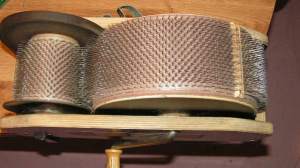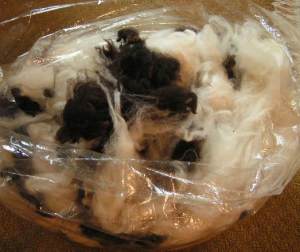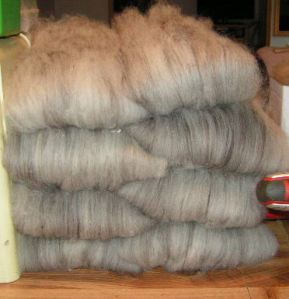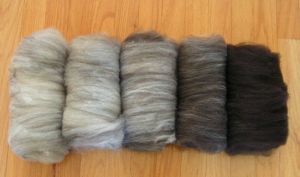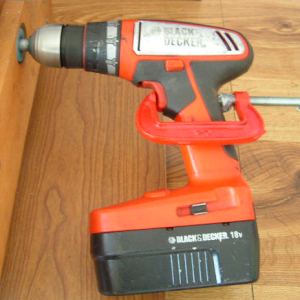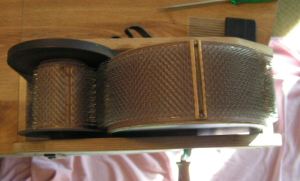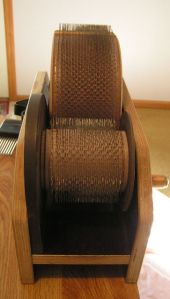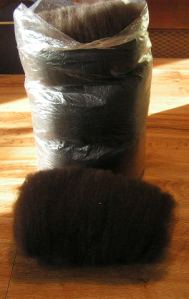Before I move on the carding, I want to record some stats – mostly for me, but I know eventually someone will ask ‘How long did it take?’ and ‘How much fiber did you use?’
Time table:
Skirting and cleaning of each fleece = 20 minutes, total of 40 minutes
Washing of each fleece = 2 hours, total of 4 hours. Although it took the better part of a day to wash each fleece, most of that time was spent in waiting while the fiber soaked, so I’m really only counting the active-duty time.
Weighing and combining colors = 20 minutes
TOTAL of time on previous post = 5 hours
Fiber total:
I’ve named the grays G1, G2, G3 and G4, from lightest to darkest respectively, and then solid black. Each of the grays is 7.5 ounces. G1 is 1.5 black, 6 white. G2 is 3 black, 4.5 white. G3 is 4.5 black, 3 white. G4 is 6 black and 1.5 white. I have about 9.5 ounce of solid black that I carded.
TOTAL fiber is 39.5 ounces
*** Special note here *** I do NOT think my shawl will require all the yarn that I will spin from this fiber, but I want to card and spin all of it to get the varied colors. When the shawl is complete, I can weigh the left over yarn and determine how much I did use and then calculate the time required for the carding and spinning of the shawl’s yarn.
Now on to the carding!
First was to clean my carder. After carding lots of unwashed fiber for felting, my carder needed a good cleaning!
Above is G1, the lightest gray. I tried to mix the fiber in a bag, but fiber does not mix like, say, cookie dough! I started carding.
After all 7.5 ounces had been carded, it still looked pretty streaked. So I split all the batts into lengthwise strips and mixed them up in the bag. And carded again.
While not perfectly blended, it is much better. Spinning and plying will further the blending process. And, I’m not looking for perfection. If I was, I could go to Walmart and buy gray yarn (okay, not alpaca yarn, but you get my point, right?) I tried to time the carding of each color. They varied somewhat, but generally took about 90 minutes per gray.
This is G2 after being carded twice.
And G3.
G4, the darkest gray.
There is more black, about 9.5 ounces, which took about 2 hours to card. I carded it twice since it took that much to get it into spinning condition.
And there they are. Although G1 and G2 look similar in the photo, as a whole, G2 is darker as the picture of the pile of batts shows.
TOTAL time for carding = 1.5 hours x 4 grays + 2 hours for black = 8 hours.
I will spending this Friday at Pioneer Days in Albany, MN doing the spinning demonstration. I’ll start spinning G1. I think I will take G2 along, but I really don’t think I will come close to finishing G1. I want to spin a relatively thin single ply, so it will take some time.

